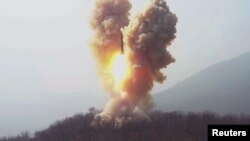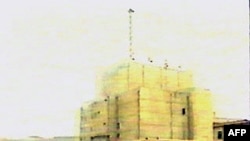On March 15, China’s Foreign Ministry commented on the latest escalation of tensions on the Korean Peninsula.
That week, North Korea, or DPRK, test-launched three ballistic missiles as U.S.-South Korea joint military exercises were taking place.
In September 2022, North Korea passed a law declaring itself a nuclear weapons state, with its leader, Kim Jong Un, calling such status “irreversible.” Last year, the DPRK test-launched some 70 ballistic missiles, according to the South’s Yonhap news agency, more than in any previous year.
On March 15, Chinese Foreign Ministry spokesperson Wang Wenbin implicitly blamed the United States for the failure of North Korea’s denuclearization process, saying:
“The main reason is that the parties concerned have refused to respond to the denuclearization measures taken by the DPRK and continued to intensify their pressuring and deterring of the DPRK.”
That is misleading.
The United States and the international community have negotiated with Pyongyang for decades to achieve North Korea’s “denuclearization.” The diplomatic efforts resulted in a mix of crises, stalemates and temporary progress.
In claiming that Pyongyang had taken “denuclearization measures,” Wang was likely referring to the breakdown of the 1994 Agreed Framework between the U.S. and North Korea, under which the DPRK temporarily froze its plutonium weapons program in exchange for U.S. aid.
North Korea, however, violated the Agreed Framework, which collapsed in January 2003 after Pyongyang announced its immediate withdrawal from the Nuclear Nonproliferation Treaty and resumed developing nuclear weapons.
Here’s how it all played out.
North Korea began building infrastructure for a nuclear weapons program in Yongbyon in the 1980s, even though the country had joined the NPT in 1985.
In 1993, there was strong evidence that the DPRK was cheating on its NPT commitments. In the meantime, the country refused repeated requests for special inspections by the United Nations’ International Atomic Energy Agency, or IAEA.
That sparked a crisis, in which the North announced its intention to withdraw from the NPT and the U.N. nuclear watchdog declared that it could not guarantee that North Korea was not using its nuclear material for non-peaceful purposes.
After numerous rounds of negotiations between Washington and Pyongyang, U.S. President Bill Clinton’s administration concluded the Agreed Framework with North Korea in October 1994.
Under that deal, North Korea agreed to freeze plutonium-producing reactors and related facilities in Yongbyon, and the IAEA would verify compliance. In exchange, the United States, Japan and South Korea would finance and build two proliferation-resistant light-water reactors, or LWRs, for North Korea.
North Korea would dismantle all the nuclear facilities in Yongbyon, upon the completion of the LWR project. And between the completion of the first LWR unit and the completion of the whole LWR project, the U.S. would supply North Korea with 500,000 tons of heavy fuel oil annually to make up for “the energy foregone due to the freeze” of the Yongbyon nuclear reactors.
That was done even though the reactor at Yongbyon “was not connected to the power grid and appeared only designed to produce plutonium, a key ingredient for nuclear weapons,” the The Washington Post wrote.
The Agreed Framework also called for the U.S. and DPRK to work together “for peace and security on a nuclear-free Korean Peninsula” and to “strengthen the international nuclear non-proliferation regime,” stipulating that North Korea would remain a party to the NPT.
After the Agreed Framework was signed, North Korea shut down its Yongbyon facilities, as the IAEA verified in November 1994. The construction of LWRs started and the U.S. annually supplied North Korea with the prescribed amount of heavy fuel oil.
However, LWR construction fell behind schedule, and delivery of heavy fuel oil was often delayed, partly because Republican members of the U.S. Congress opposed the agreement, viewing it as “appeasement” that rewarded North Korea for bad behavior.
Still, numerous North Korean provocations fueled opposition to the deal on Capitol Hill.
For example, throughout the 1990s and 2000s, North Korea ramped up its exports of ballistic missile technology — mainly to Iran, Syria, Egypt, Libya and Pakistan — heightening concerns over weapons proliferation.
In October 1996, the U.S. deployed a reconnaissance ship and jet to Japan after it detected that North Korea was preparing to test-launch its medium-range Nodong missiles.
On August 31, 1998, North Korea launched a nuclear-capable Taepodong-1 missile over Japan, a party to the LWR project. Two months later, U.S. intelligence reported that North Korea was building two new launch facilities for the Taepodong-1.
The 1998 missile launch prompted the Clinton administration to undertake an interagency review of U.S. policy toward North Korea. That launch also contributed to delaying construction of LWRs.
Commenting on North Korea’s provocations in the years following the agreement, Donald Gregg, former U.S. ambassador to South Korea, told the Public Broadcasting Service:
“[T]hat kind of hostile activity inflames Republicans, inflamed the people of South Korea, caused some delay in the oil shipments, and accounted for a lot of the delay in building the light-water reactors, which the North Koreans never acknowledged.”
Still, the agreement mostly held up until 2002, when the U.S., citing intelligence reports, accused North Korea of secretly enriching uranium for nuclear weapons. Pyongyang reportedly confirmed in October 2002 that it had enriched uranium for nuclear weapons and claimed it had the right to do so.
“North Korea's secret nuclear weapons program is a serious violation of North Korea's commitments under the Agreed Framework as well as under the Nuclear Nonproliferation Treaty, its International Atomic Energy Agency safeguards agreement, and the Joint North-South Declaration on the Denuclearization of the Korean Peninsula,” the U.S. State Department said in October 2002.
In response, President George W. Bush’s administration suspended heavy fuel oil deliveries, with the last shipment reaching North Korea on November 18, 2002.
Pyongyang kicked IAEA inspectors out of the country in December 2002, withdrew from the NPT in January 2003 and restarted the nuclear reactors and related facilities formerly frozen under the Agreed Framework.
Thus began the second North Korean nuclear crisis, followed by more than a decade of new bilateral and multilateral talks aiming to denuclearize North Korea, all to no avail.
See a detailed timeline of U.S.-North Korea nuclear and missile diplomacy efforts here.






